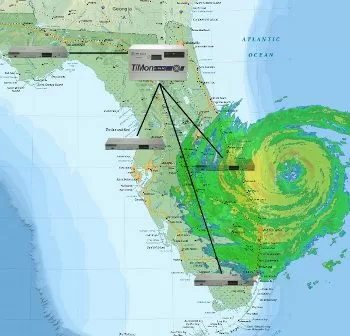Download our free Monitoring Fundamentals Tutorial.
An introduction to Monitoring Fundamentals strictly from the perspective of telecom network alarm management.
1-800-693-0351
Have a specific question? Ask our team of expert engineers and get a specific answer!
Sign up for the next DPS Factory Training!

Whether you're new to our equipment or you've used it for years, DPS factory training is the best way to get more from your monitoring.
Reserve Your Seat TodayThere's been a long period of relative quiet when it comes to hurricanes in the United States. It's easy to forget just how devastating these massive storms can be to telecom, power, and public-safety infrastructure. Someday in the not-too-distant future, the preparations you make today will be put to the test. Will you be ready?
In a hurricane, sites spanning hundreds of miles may be knocked out simultaneously. The whole country is watching as you race against the clock. You have to:

Imagine all the problems that can happen during and after a hurricane. Some sites are orphaned when communication lines are severed. Other sites remain up, but they're now dependent on dwindling backup generator fuel. First responders can lose radio communications when they're trying to save lives.
Phone networks and 911 dispatch centers can fail when emergency services are needed most. Commercial power failures knock out food refrigeration and climate control, threatening the safety of your local residents.
Natural disasters like hurricanes make it clear why remote monitoring is so important. It can feel difficult to justify the purchase of monitoring equipment when times are good. Nobody wants to "waste money" on equipment they don't need. But monitoring manufacturers get a rush of panicked calls following natural disasters, because now everyone (from technician to CEO) is laser-focused on their recent failure.
In a disaster scenario, it's almost impossible to have wasted remote-monitoring budget dollars. Still, there are a few particular areas that you can focus on.
1) Monitor 100% of your mission-critical equipment
With each piece of gear you tie into a remote-monitoring system, you improve your situational awareness. During disaster recovery, that pays dividends. Maybe you're sending a technician to a site already to fix an HVAC unit, but you also notice that a switch has failed. Have the technician take an extra part or the right tool, and you can finish the job on the first trip.
2) Monitor battery voltages & generator fuel levels
When the storm rolls through, you're probably going to lose commercial power at many of your sites. If you know precisely how much backup power you have, you can use your limited response teams in the best way possible. You can rush to the sites that will need fuel first.
3) Program automatic responses to specific alarms
Some sites may not go fully offline in a hurricane. You might just lose communications to the site. If you've programmed the local equipment to handle specific dangers with specific responses, it can protect itself when you're not available. Imagine a site that knows its interior temperature has risen to 90 degrees (F) after an HVAC failure. It automatically shuts down auxiliary equipment to reduce the heat load, buying precious minutes of extra uptime. These kinds of intelligent responses are possible with the right remote-monitoring system.
When Hurricane Rita struck Louisiana in the fall of 2005, Keith and his team saw their DPS remotes pass one of Mother Nature's fiercest tests. Even though the Cameron staff relocated to another central office, they still had to watch over their network. "We were still able to monitor all of our sites and pick up alarms," Keith said. "DPS monitoring allowed us to have an accurate overview of our entire network at a very critical time."

"Where we had NetGuardians, we were able to look at the voltage and watch it drop," he said. "We were able to determine from that number when we needed to take a generator out. We could look at sites and tell, 'This one has more voltage than this one, so we need to move a generator here.' These proved to be an invaluable tool during one of our company's biggest crises."